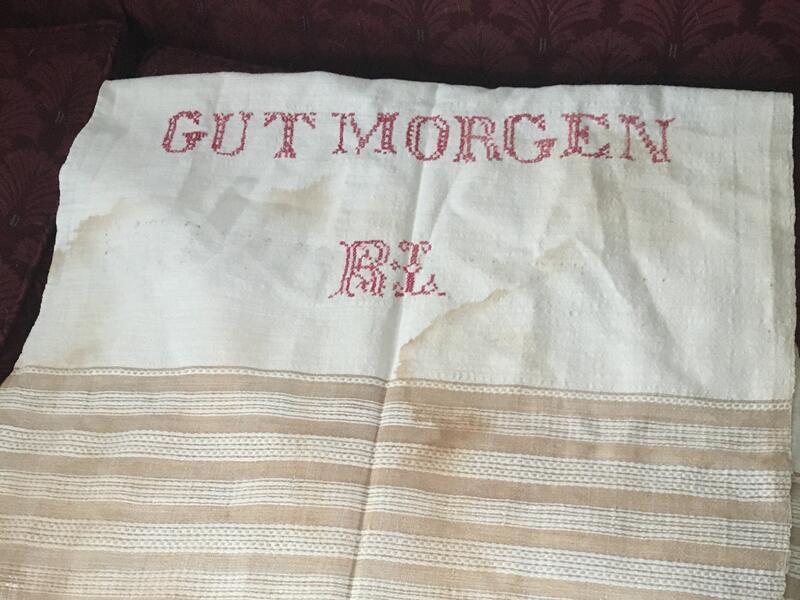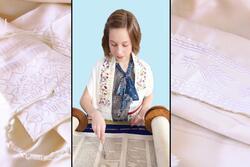Restoring Hope Along with a Family Heirloom
I never met my Great Aunt Rifka or even saw a photograph of her. Yet I’ve always had a clear picture of her in my mind, sitting in a wheelchair, smiling. She has no legs (a result of diabetes) and she’s wearing a fur stole with fox heads.
My mother said that Great Aunt Rifka, my grandmother’s sister, always treated her kindly—unlike all my father’s other relatives, who could only think of her as a “shiksa.” (My Irish Catholic mom and my Jewish dad married in 1943, right before he left for military training in Atlanta).
My parents’ marriage ended in divorce, after years of trauma and adultery. But somehow, in those complicated ensuing years, Great Aunt Rifka remained a shining star in my mother’s memory. She recalled how Rifka taught her to make knishes and latkes. I don’t know if she singled my mother out to make her feel welcome, or if she made everyone feel like they truly counted. I know little else of her except that she lived near Chicago, as did most of my grandmother’s relatives who had immigrated from Romania to America.
My mother knew Rifka before she lost her legs and said that while some people might have become bitter from that experience, she maintained her kind, generous spirit. “She was a peach through and through,” my mother often said.
I don’t know anything about Great Aunt Rifka’s later life or death, because my mother lost contact with her after my parents divorced. But I own a couple of her possessions. Ever since high school I’ve collected vintage clothing and household items. So, after my grandma died, I was allowed to rummage through her stuff and take almost anything I wanted. The dining room set, the dishes from my dad’s bris, old linens, and armloads of clothes. I was in heaven—musty, but glorious.
One of the items I stumbled upon was Great Aunt Rifka’s fur stole with fox heads, the kind with beady eyes that dangled over your shoulders. I wore it to the theater a few times and once to a large Thanksgiving gathering and it got some raised eyebrows. I put it away. Years later, when I procured it from a box, I found that it had begun to disintegrate. Furry puffs filled the air when I lifted it up, and a foot fell off. I didn’t know at the time that moths had gotten to it. It took many moth infestations to understand their destructive power. I learned that to preserve vintage clothing, the freezer is best. Even today, if you open my freezer, you’re likely to find a vintage hat or a wool vest inside.
Over the course of the pandemic, I’ve been sorting and organizing every container in the house, partly as a war against moths (in addition to the freezer, crushed bay leaves are great), and to lighten the task for my children after I’m gone. In one of the boxes, I found embroidered linens from my grandma’s house. I knew my grandma didn’t do the embroidering. She made the best roast chicken and a succulent pineapple upside-down cake, but did no sewing or crafts. It’s quite possible that Great Aunt Rifka adorned all of the lovely items, but I knew for sure she’d made at least one: a heavy, linen table runner, white in the middle, tan and white stripes on the ends, with white fringe. The embroidery is in one-inch, red, fancy letters: R.L., Rifka's initials. And underneath those, Gut Morgen (“good morning” in Yiddish). A breakfast cloth, perhaps.
The cloth was covered with water stains. My daughter, also a collector, suggested I soak the whole thing in a sink full of water with baking soda. I tried that first, but the stains remained. A long soak in vinegar water, then Dawn dish soap. The water was so dark I couldn’t believe it was draining from white material. The result was a clean and fresh-smelling cloth—but the water stains were no lighter.
While squeezing out the water after each attempt, it occurred to me that I owed Great Aunt Rifka a full restoration. Wasn’t she the “peach” to whom my mother remained loyal decades after her marriage disintegrated? I headed to the basement for the bottle of bleach.
First, I poured a capful on a tiny section, followed by a capful of water. Then I dab-dab-dabbed and immediately rinsed under the faucet. Going over the cloth inch by inch, it struck me that with the fringe on the ends, the cloth resembled a tallis. Could this have been in Great Aunt Rifka’s mind as she designed the cloth? Had she privately used it to wrap herself in for morning prayers?
As I painstakingly made my way toward her initials, I wondered just how old the cloth was. Surely, R.L. stood for Rifka Leibowitz; unless she had married someone with a last name starting with L, she had done this embroidering as a young, single woman in America. Or maybe she’d even brought it from Romania. This cloth could be close to a hundred years old. I held my breath, expecting it to fall apart from the bleach. But I kept at it because it appeared to be holding up and not changing—just as my mother had described Aunt Rifka’s spirit staying the same, even after she lost her legs.
I continued to dab with one finger, driven by a fierce loyalty to a woman I’d never met. When I was done, I stretched out the cloth on a flannel sheet in the basement to dry and was amazed that by the next day, the white middle was stain-free. When I held it up to the light, I noticed that one of the striped ends also had some water stains. Had I missed them before, or had I caused them in my process? Buoyed on by the spirit of Great Aunt Rifka, I returned to the kitchen and submerged the whole striped end into a sinkful of bleach water. It’s currently drying once again on the flannel sheet and, at last check, is looking good.
My mother never relinquished her devotion to my father’s aunt, even though hope, joy and innocence were drained from their marriage. Restoring this linen feels like a tribute to my Great Aunt Rifka for the risk she took by accepting and bestowing loving attention on my mother, in defiance of her family.
During the pandemic, I’ve begun a new practice each morning of adding the morning prayer, Modeh Ani to my usual yoga posture. Maybe I’ll try wrapping myself in the Gut Morgen cloth when I do that—and it just might restore hope, joy and innocence at this challenging time.
I’ll also continue to place vintage hats in the freezer and treasure all the linens embroidered by family. More importantly, I’ll hold in my heart Great Aunt Rifka and the other people in my life who have inspired risk-taking, loyalty, and perseverance.








Thoroughly loved reading this. Very poignant.